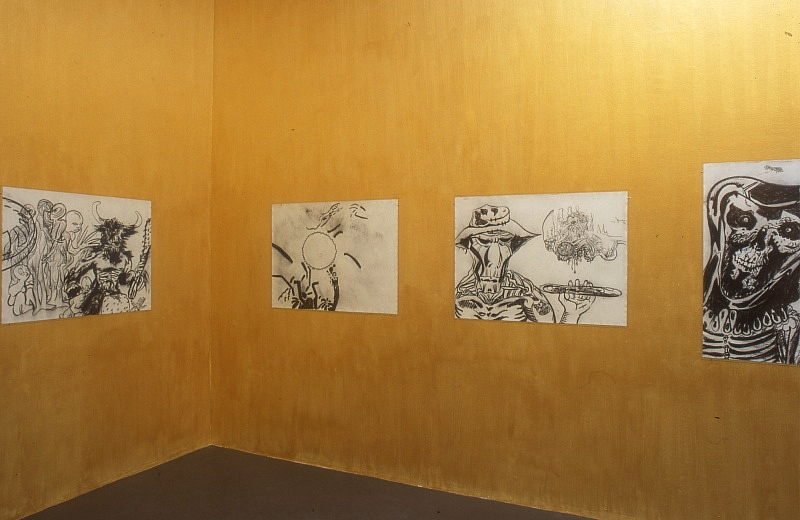Although they have no clear thematic affinity to the paintings, the new drawings of Rob Birza cannot be regarded as designs or preparatory sketches. Within his versatile range of work, the drawings have always had a prominent and independent place. This time it is striking that all of them have been done in charcoal and without the use of color. Birza is often renowned for his use of bright, rich colors. Now everything is black and white, though Birza did give the walls of the rooms some color for the occasion. The drawings show an amazing procession of freaks which peer at and sneak up on us from the paper. Scary faces, sunken eyes, itchy claws and wide-open jaws: we find ourselves in a veritable house of horrors. The drawings have been executed with speed and ferocity and, with fitting `horror vacui', the sheets of paper have been vehemently drawn full. For this parade of horror the artist has taken inspiration from popular magazines with bloodcurdling titles such as eXtreme destroyer, Evil Ernie and Birthquake. At the same time, he has freed the legion of zombies and freaks of the typical comic-strip narrative: the usual bubbles of text and cries of distress in strip typography have been omitted, and the austere drawing style of the strip has been replaced with the more academic and studious charcoal sketch. This puts the bizarre monsters and the morbid humor of the original horror stories into perspective, and the frightening pictures are reduced to images that sooner play on the imagination than on fear. Within that realm of art, the monsters lose their blood-ties with comic strips, animation films and computer games and become linked instead with the fantastic tradition of artists such as Jeroen Bosch, Pieter Breughel and, more recently, James Ensor.
In earlier work Rob Birza has already shown his fascination with popular culture, utilitarian objects and cheap materials. `High art' and `low art' are continually mixed and turned around in his work. Visual references can refer to art history as well as to comic strips and cartoons: for Birza it is all material for arriving at new images. The freedom of appropriation is not a postmodernist principle to him, but an artistic and mental necessity for the conquering of inner obstacles. In this there is no compromise; it's all or nothing. The same liberty is taken by him in his use of materials and in the artistic experiments that he is constantly undertaking. What ultimately count are the visual qualities of the work, but the roads that lead to a good work of art are always varied and always new. In order to keep his work energetic and full of inspiration, Birza alters expectations and adjusts meanings time and again. The notions `beautiful' and `ugly' are relativized in the process. His beautifully painted floral still lifes from the series Power Flower Portraits, for instance, could just as easily be about pain and aggression as about beauty and joie de vivre.
The new monsters and creeps have origins somewhere between Jeroen Bosch and Walt Disney but are also the projections of inner fears and phantoms. As in a magic spell, the artist has liberated himself in the act of drawing, and here too he has managed to bring about a reversal; the monsters no longer appear to be so very scary and threatening . They're also a bit kind and cosy.
In earlier work Rob Birza has already shown his fascination with popular culture, utilitarian objects and cheap materials. `High art' and `low art' are continually mixed and turned around in his work. Visual references can refer to art history as well as to comic strips and cartoons: for Birza it is all material for arriving at new images. The freedom of appropriation is not a postmodernist principle to him, but an artistic and mental necessity for the conquering of inner obstacles. In this there is no compromise; it's all or nothing. The same liberty is taken by him in his use of materials and in the artistic experiments that he is constantly undertaking. What ultimately count are the visual qualities of the work, but the roads that lead to a good work of art are always varied and always new. In order to keep his work energetic and full of inspiration, Birza alters expectations and adjusts meanings time and again. The notions `beautiful' and `ugly' are relativized in the process. His beautifully painted floral still lifes from the series Power Flower Portraits, for instance, could just as easily be about pain and aggression as about beauty and joie de vivre.
The new monsters and creeps have origins somewhere between Jeroen Bosch and Walt Disney but are also the projections of inner fears and phantoms. As in a magic spell, the artist has liberated himself in the act of drawing, and here too he has managed to bring about a reversal; the monsters no longer appear to be so very scary and threatening . They're also a bit kind and cosy.
